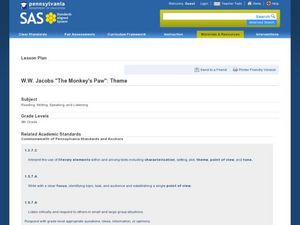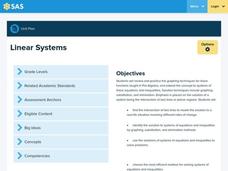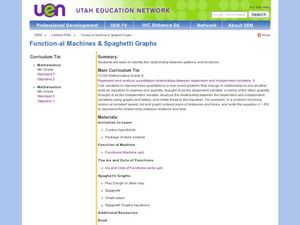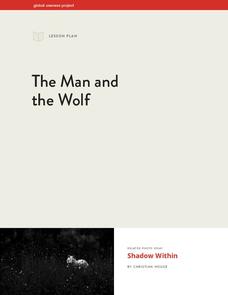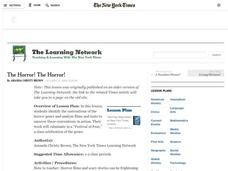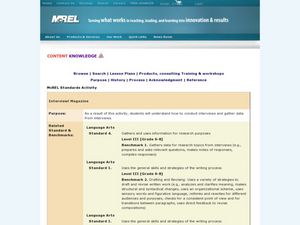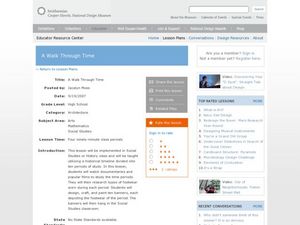Curated OER
W.W. Jacob's "The Monkey's Paw" Theme
Students identify the theme of "The Monkey's Paw" and relate it to prior knowledge. In this "The Monkey's Paw" lesson, students discuss fate and coincidence and debate which one controls destiny. A test is chosen as the...
Curated OER
Linear Systems
Students solve and graph linear equations. In this algebra lesson, students solve systems of equations using elimination and substitution. They graph their answer and identify the point of intersection.
Curated OER
GPS Scavenger Hunt
Learners go on a GPS scavenger hunt. They use GPS receivers to find designated waypoints and report back on what they found. They compute distances between waypoints based on the latitude and longitude, and compare with the distance the...
Curated OER
Moving without Wheels
Students observe a simple water cycle model to better understand its role in pollutant transport. This activity shows one way in which pollution is affected by the water cycle; it simulates a point source of pollution in a lake and the...
Curated OER
It's About Time
Students investigate how Global Positioning Systems work and how and why GPS receivers make errors. They graph data points and apply estimation and prediction to real-life GPS situations, discuss time delay, and complete a worksheet.
Curated OER
Function-al Machines and Spaghetti Graphs
Sixth graders identify the relationship between patterns and functions. In this algebra lesson, 6th graders use a "Functional Machine" to identify the rule. Students use a function table to plot the points using play dough dots.
Teach With Movies
Title: "The Yearling" - Topics: Literature/U.S.; U.S./1865-1913 & Florida
Life in the Florida swamps after the Civil War comes alive in the 1946 film adaptation of Majorie Kinnan Rawlings’s The Yearling. The film of this powerful coming-of-age story, filled with love and loss, can be used with or without a...
Global Oneness Project
The Man and the Wolf
Human attitudes toward the big bad wolf come into focus in a photo essay that asks viewers to consider their own feelings about the endangered species.
Shodor Education Foundation
Plop It!
Build upon and stack up data to get the complete picture. Using the applet, pupils build bar graphs. As the bar graph builds, the interactive graphically displays the mean, median, and mode. Learners finish by exploring the changes in...
Starry Night Education
Comets and Meteors
Comets are also known as dirty snowballs or icy mud balls. With your super scientists, create a model comet nucleus to discover how they are made and take part in a scientific discussion to learn how it behaves.
The New York Times
The Horror! The Horror!
Gear up for Halloween by studying the horror genre with your class and analyzing films and texts to uncover the genre's traditional conventions.
Curated OER
Girders and Wrecking Ball Activity
As learners build the "girders" of conversation by staying consistent on a particular topic, they avoid the "wrecking ball" of an off-topic comment. To help students develop this important conversation skill, this resource provides...
Transforming Education
SEL for Educators Toolkit
Four resources make up the SEL toolkit for educators. Intended for those that teach kindergarten to twelfth grade, helpful files include a companion guide, presentation, reference list, and a one-page snapshot that neatly showcases the...
Curated OER
Summarizing Political Cartoons by Using Standard Parts of Speech
Students analyze a political cartoon, and at the same time cover the basic parts of speech, in order to view a cartoon and determine its subject, action verb, and object.
Curated OER
20th Century II: The 1940's - The War
Students watch the movie The Tuskegee Airmen. Write a one page typed paper that describes the obstacles the African-American servicemen, particularly these aviators, had to over come to defend their country. They use specific scenes from...
Curated OER
A Penny For Your Thoughts: Cross-Curricular Journal Writing
Students are introduced to the importance of journal writing. After creating their own journal, they write their thoughts and feelings about different subjects. If they choose to they can share their writings with the class to end the...
Curated OER
Interview! Magazine
Students interview a subject and write a biographical sketch for a fictional magazine. In this interview lesson, students choose a person to interview and create two sets of questions. Students conduct the interview. Students then write...
Curated OER
Moving Lines
Pupils gain an introduction to gestural line drawing along with art history correlations. They are encouraged to focus on the energy, mass, and expression of the subject rather than on illustrated replication.
Curated OER
A Walk Through Time
Students investigate the types of footwear worn during ten periods of history. For this secondary, art/math/social studies lesson, students view documentaries and popular films to study the time periods. Students research the...
Curated OER
The Age of Exploration
Students study the Age of Exploration. In this Exploration lesson, students prepare for a test on the lesson by discovering details about the explorers of the age as they view a PowerPoint presentation.
Curated OER
What Do You Do With An Orphaned Cheetah?
Students brainstorm techniques for teaching baby cheetahs survival skills. In this science lesson, students view an episode of "Cheetah Orphans" and work together to analyze the situation and develop a plan to teach the baby cheetahs the...
Curated OER
Ethical Problems Surrounding Surrogate Motherhood
Students examine the definition of surrogacy and the types of surrogacy. They analyze surrogacy and the law. They conduct debates, skits and teen forums regarding the subject of surrogacy.
Curated OER
Globalization101.org Lesson Plan on Prescription Drug Prices
Students examine the issue of prescription drug prices in the United States. They research the issue and participate in a mock US Senate hearing on the subject.
Curated OER
Powers of Observation - HANDS
Fifth graders create individual works of art using human hands as the subject. The lesson is for a single 45-minute class. Rubric on student assessment is addressed in this standards-based lesson.


